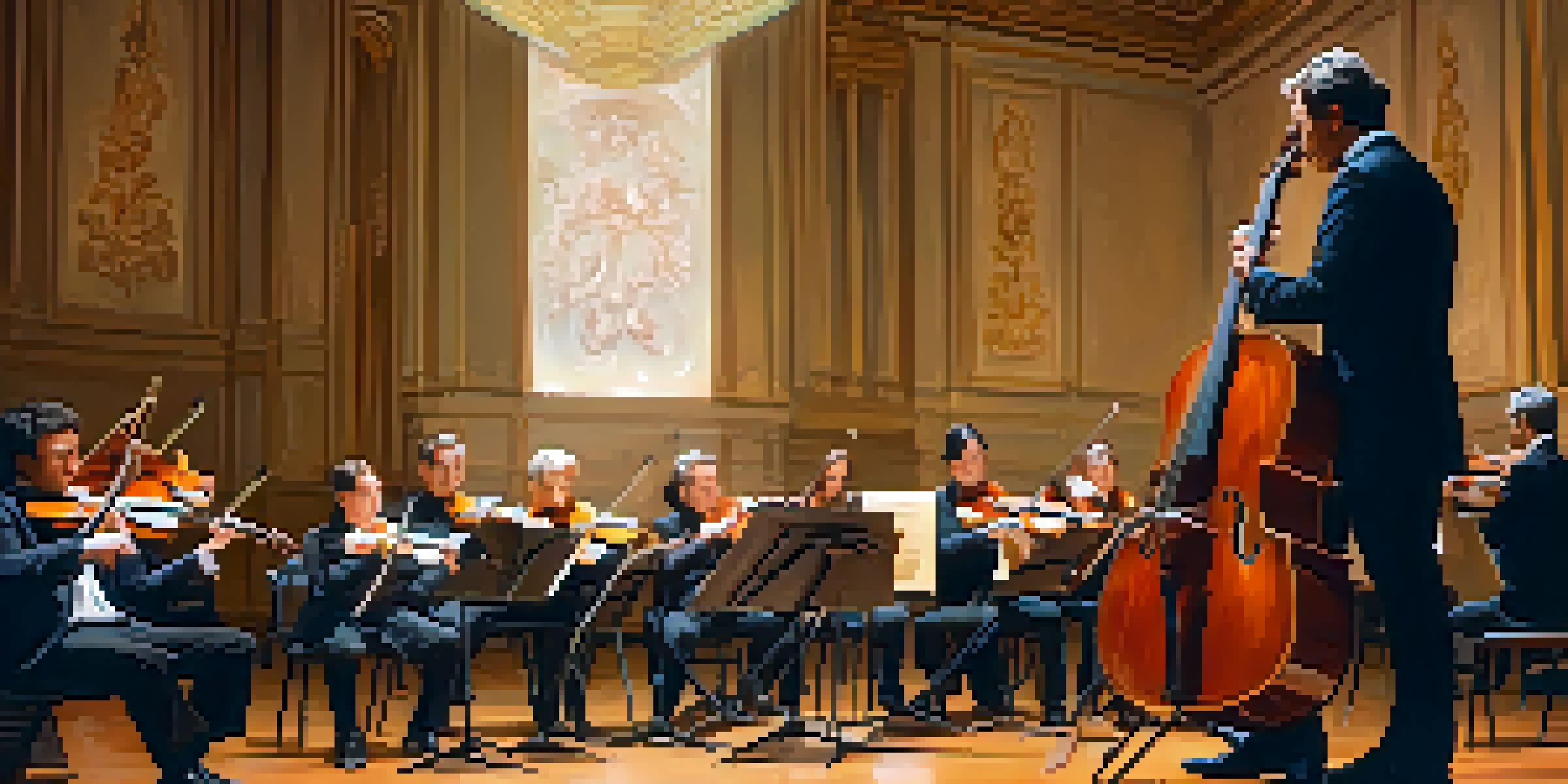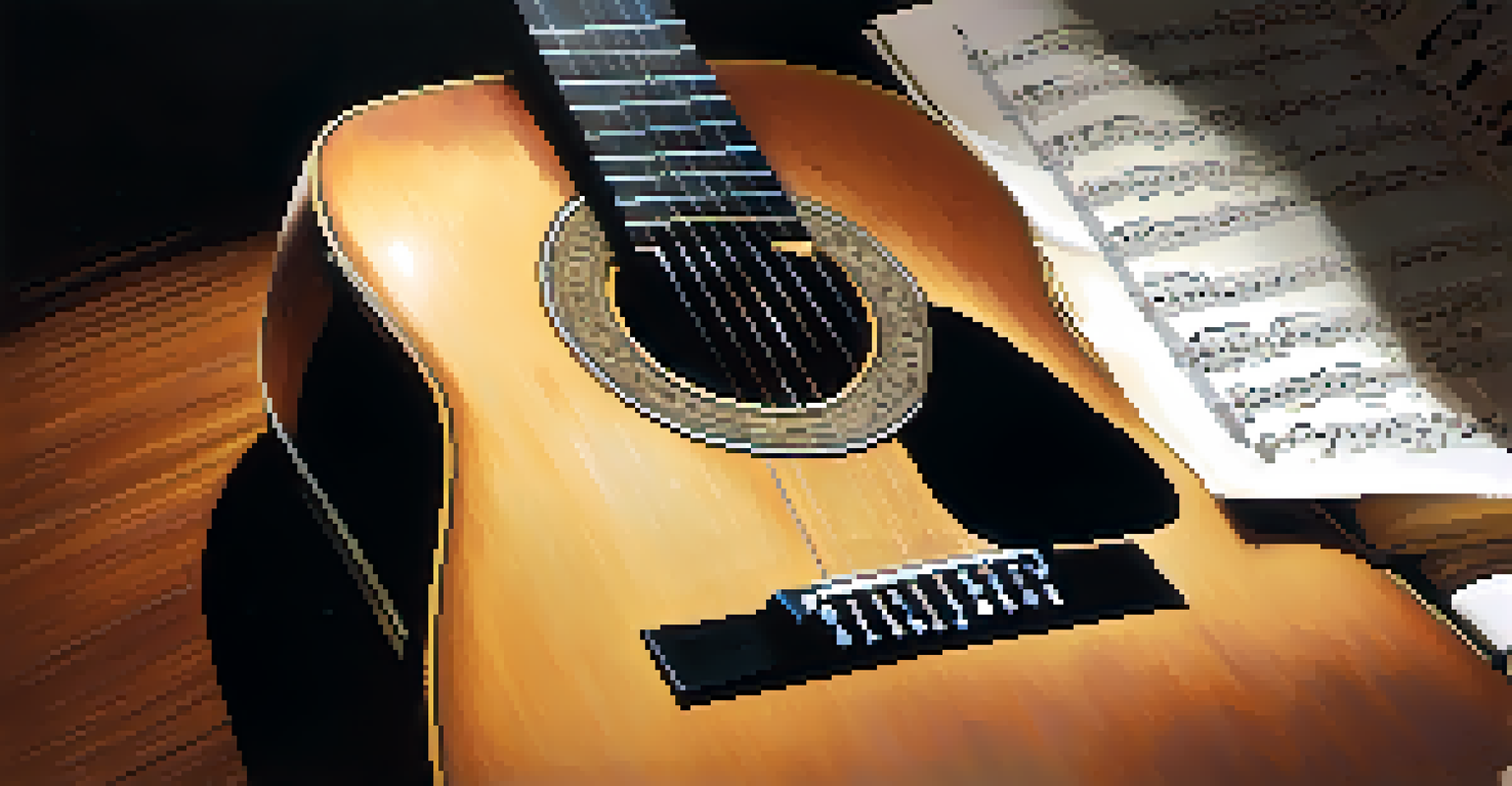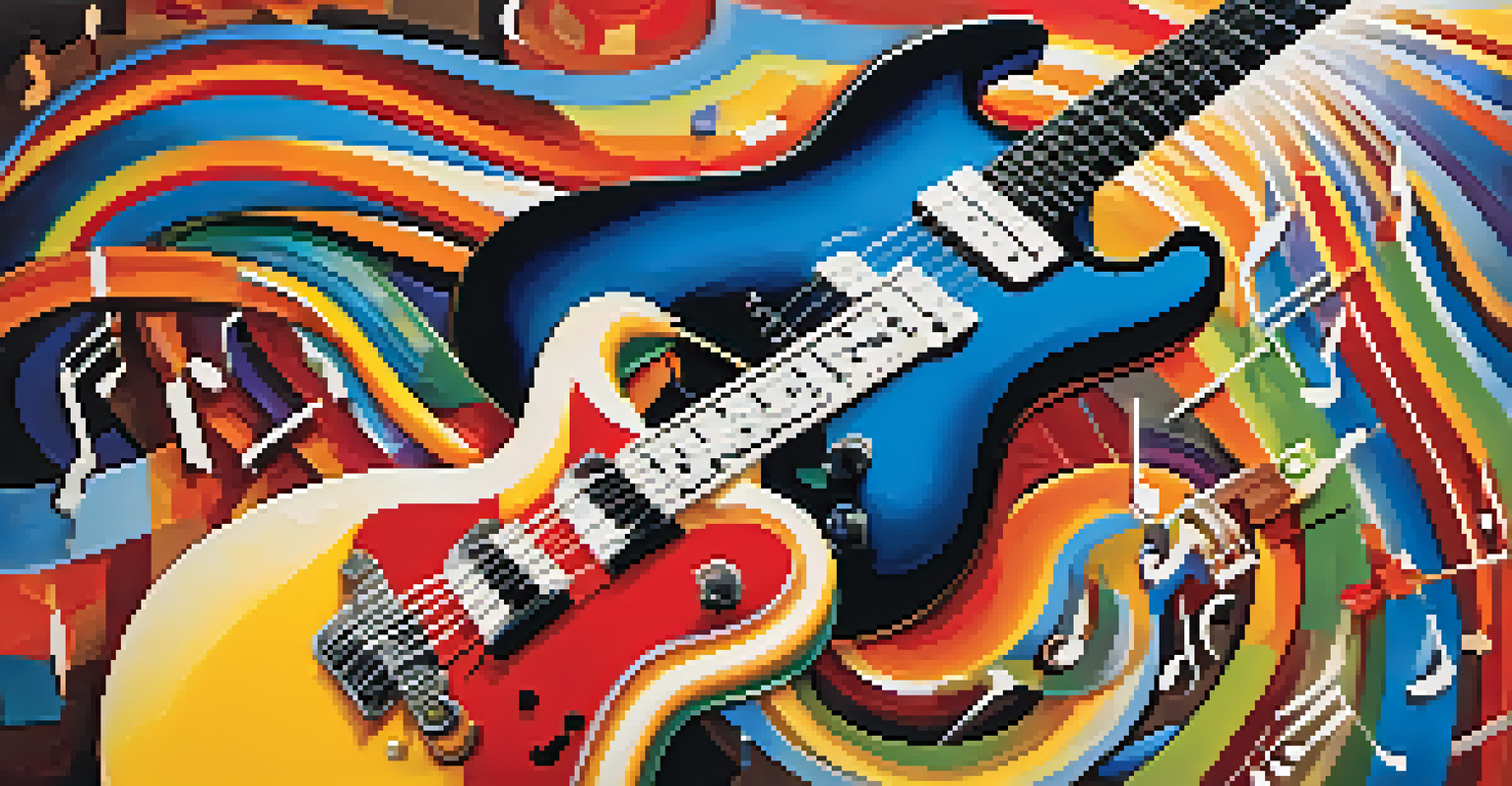The Guitar and the Orchestra: Collaborations with Classical Musicians

The Guitar's Unique Voice in Classical Music
The guitar, often associated with folk and rock genres, brings a unique voice to classical music. Its warm tones and intricate melodies can beautifully complement orchestral arrangements. This versatility allows composers to explore new sonic landscapes, merging traditional classical elements with the guitar's distinct sound.
The guitar is a miniature orchestra in itself.
Instruments like the violin and cello have long held their places in the orchestra, but the guitar offers a refreshing alternative. Its ability to strum chords and deliver melodic lines simultaneously adds depth to the orchestra's texture. This blending of sounds creates a rich auditory experience for the audience, allowing for dynamic performances.
Many classical composers, such as Joaquín Rodrigo and Heitor Villa-Lobos, have recognized this potential. They have written concertos specifically for guitar and orchestra, showcasing how well these two worlds can collide. The result is a captivating fusion that pushes the boundaries of classical music.
Famous Guitar and Orchestra Collaborations
Throughout history, numerous collaborations have highlighted the guitar's role within orchestras. One notable example is Andrés Segovia, a legendary guitarist who performed with prominent orchestras worldwide. His interpretations of classical pieces not only showcased the guitar's capabilities but also elevated its status in the classical realm.

Another significant collaboration is the Concerto de Aranjuez by Joaquín Rodrigo, which features the guitar as a solo instrument against the backdrop of a full orchestra. This piece has become a staple in both classical and popular music, demonstrating the guitar's ability to shine in orchestral settings.
Guitar Enhances Classical Music
The guitar's warm tones and melodic versatility add a unique voice to orchestral arrangements, enriching the overall listening experience.
Moreover, contemporary artists like the guitar virtuoso Miloš Karadaglic continue to bridge the gap between genres. By collaborating with orchestras, these musicians breathe new life into classical compositions, making them accessible to a broader audience while maintaining the integrity of the original works.
The Role of the Guitar in Modern Orchestras
In modern orchestras, the guitar's role has evolved significantly. It is no longer just a solo instrument; it can also provide harmonic support, rhythmic foundation, and even texture. This versatility allows composers and conductors to experiment with different styles, incorporating influences from jazz, rock, and world music.
Music is the universal language of mankind.
Some orchestras have even begun to include electric guitars in their performances, opening up new possibilities for sound exploration. This integration of electric guitars allows for a fusion of classical music with contemporary genres, appealing to younger audiences who might not typically attend orchestral concerts.
As orchestras seek to innovate and attract diverse audiences, the guitar's presence is becoming increasingly vital. This evolution reflects a broader trend in the music world, where genres blend and boundaries blur, creating a rich tapestry of sound that resonates with listeners from all walks of life.
Compositional Techniques for Guitar and Orchestra
Composers writing for guitar and orchestra often employ unique techniques to highlight the guitar's strengths. For instance, they might use call and response, where the guitar plays a phrase followed by the orchestra. This interaction creates a conversational dynamic that engages the audience and showcases the dialogue between the two instruments.
Additionally, composers might explore different textures and timbres by varying the orchestration. By pairing the guitar with different sections of the orchestra, such as woodwinds or brass, they can create contrasting sounds that enhance the overall composition. This approach not only highlights the guitar but also enriches the orchestral experience.
Collaborations Expand Guitar's Role
Historical and contemporary collaborations, such as those with Joaquín Rodrigo and modern virtuosos, highlight the guitar's significant contribution to orchestral music.
Moreover, techniques like pizzicato in string sections can mimic the guitar’s plucking style, creating a cohesive sound. These thoughtful compositional choices ensure that the guitar is not just an addition to the orchestra but an integral part of the musical narrative.
The Impact of Guitar on Audience Perception
The inclusion of the guitar in orchestral performances can significantly impact audience perception. Many people who may not typically enjoy classical music find themselves captivated by the guitar's familiar sound. This connection can draw in new listeners, expanding the audience base for orchestral music.
Moreover, the guitar's ability to evoke emotion makes it a powerful tool for composers and conductors. When audiences hear the plaintive notes of a guitar intertwined with orchestral harmonies, it can create an emotional resonance that's hard to ignore. This emotional depth can transform a concert experience into something truly unforgettable.
As orchestras continue to embrace the guitar, they also challenge traditional views of classical music. By showcasing diverse instruments and styles, orchestras can create performances that resonate with a wider range of emotions and experiences, enriching the cultural landscape of music.
Educational Opportunities for Guitarists in Orchestras
For aspiring guitarists, the opportunity to collaborate with orchestras can be a transformative experience. Many music programs and conservatories now offer specialized training that focuses on orchestral performance for guitarists. This training equips them with the skills necessary to navigate the unique challenges of playing in a large ensemble.
Participating in orchestral settings can also help guitarists develop their listening skills and improve their ability to blend with other instruments. Learning to balance their sound with the orchestra's dynamics is crucial for a successful performance. This experience fosters a deeper understanding of music as a collaborative art form.
Innovative Future for Guitar and Orchestra
As composers experiment with diverse styles and technology, the future promises exciting new collaborations that blend classical music with contemporary influences.
Additionally, these educational opportunities can lead to networking connections within the music industry. Collaborating with established orchestras and musicians opens doors for future performances and projects, paving the way for a successful career in music.
The Future of Guitar and Orchestra Collaborations
As music continues to evolve, the future of guitar and orchestra collaborations looks promising. With an increasing number of composers experimenting with diverse sounds, the guitar's role is likely to expand even further. This trend suggests a bright future for innovative compositions that blend genres and styles.
Moreover, advancements in technology allow for new performance possibilities. The use of amplification and effects can enhance the guitar's sound within orchestral settings, creating exciting sonic landscapes that captivate audiences. This fusion of technology and artistry could lead to groundbreaking performances that redefine classical music.

Ultimately, as musicians and composers continue to explore the intersection of guitar and orchestra, they will create fresh, engaging experiences for audiences. This collaboration not only enriches the music but also fosters a greater appreciation for both the guitar and orchestral traditions.